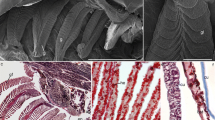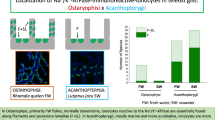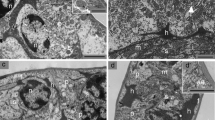Abstract
The tissue distribution and ontogeny of Na+/K+-ATPase has been examined as an indicator for ion-regulatory epithelia in whole animal sections of embryos and hatchlings of two cephalopod species: the squid Loligo vulgaris and the cuttlefish Sepia officinalis. This is the first report of the immunohistochemical localization of cephalopod Na+/K+-ATPase with the polyclonal antibody α (H-300) raised against the human α1-subunit of Na+/K+-ATPase. Na+/K+-ATPase immunoreactivity was observed in several tissues (gills, pancreatic appendages, nerves), exclusively located in baso-lateral membranes lining blood sinuses. Furthermore, large single cells in the gill of adult L. vulgaris specimens closely resembled Na+/K+-ATPase-rich cells described in fish. Immunohistochemical observations indicated that the amount and distribution of Na+/K+-ATPase in late cuttlefish embryos was similar to that found in juvenile and adult stages. The ion-regulatory epithelia (e.g., gills, excretory organs) of the squid embryos and paralarvae exhibited less differentiation than adults. Na+/K+-ATPase activities for whole animals were higher in hatchlings of S. officinalis (157.0 ± 32.4 µmol g −1FM h−1) than in those of L. vulgaris (31.8 ± 3.3 µmol g −1FM h−1). S. officinalis gills and pancreatic appendages achieved activities of 94.8 ± 18.5 and 421.8 ± 102.3 µmolATP g −1FM h−1, respectively. High concentrations of Na+/K+-ATPase in late cephalopod embryos might be important in coping with the challenging abiotic conditions (low pH, high pCO2) that these organisms encounter inside their eggs. Our results also suggest a higher sensitivity of squid vs. cuttlefish embryos to environmental acid-base disturbances.






Similar content being viewed by others
References
Arnold JM (1965) Normal embryonic stages of the squid, Loligo pealii (Lesueur). Biol Bull 128:24–32
Bolner KCS, Baldisserotto B (2007) Water pH and urinary excretion in silver catfish Rhamdia quelen. J Fish Biol 70:50–64
Bone Q, Brown E, Travers G (1994) On the respiratory flow in the cuttlefish Sepia officinalis. J Exp Biol 194:153–165
Boron WF (2004) Regulation of intracellular pH. Adv Physiol Educ 28:160–179
Boucher-Rodoni R, Mangold K (1977) Experimental study of digestion in Octopus vulgaris (Cephalopoda, Octopoda). J Zool Lond 183:505–515
Boucher-Rodoni R, Mangold K (1994) Ammonia production in cephalopods, physiological and evolutionary aspects. Mar Fresh Behav Physiol 25:53–60
Budelmann BU, Schipp R, Boletzky S von (1997) Cephalopoda. In: Harrison FW, Kohn AJ (eds) Microscopic anatomy of invertebrates, vol 6A. Wiley-Liss, New York, pp 119–414
Charmantier G, Charmantier-Daures M (2001) Ontogeny of osmoregulation in crustaceans: the embryonic phase. Am Zool 41:1078–1089
Charmantier G, Haond C, Lignot J-H, Charmantier-Daures M (2001) Ecophysiological adaptation to salinity throughout a life cycle: a review in homarid lobsters. J Exp Biol 204:967–977
Cieluch U, Charmantier G, Grousset E, Charmantier-Daures M, Anger K (2005) Osmoregulation, immunolocalization of Na+/K+-ATPase, and ultrastructure of branchial epithelia in the developing brown shrimp, Crangon crangon (Decapoda, Caridea). Physiol Biochem Zool 78:1017–1025
Claiborne JB, Edwards SL (2002) Acid-base regulation in fishes: cellular and molecular mechanisms. J Exp Zool 293:302–319
Colina C, Rosenthal JJC, DeGiorgis JA, Srikumar D, Iruku N, Holmgren M (2007) Structural basis of Na+/K+-ATPase adaptation to marine environments. Nat Struc Mol Biol 14:431
Dean RB (1941) Theories of electrolyte equilibrium in muscle. Biol Symp 3:331–348
Donaubauer HH (1980) Adenosine triphosphatase localization in the branchial heart of Sepia officinalis L. (Cephalopoda). Histochemistry 69:27–37
Donaubauer HH (1981) Sodium- and potassium-activated adenosine triphosphatase in the excretory organs of Sepia officinalis (Cephalopoda). Mar Biol 63:143–150
Emanuel CF, Martin AW (1956) The composition of octopus renal fluid. J Comp Physiol 39:226–234
Evans DH, Piermarini PM, Choe KP (2005) The multifunctional fish gill: dominant site of gas exchange, osmoregulation, acid-base regulation, and excretion of nitrogenous waste. Physiol Rev 85:97–177
Fagan MJ, Saier MH (1994) P-type ATPases of eukaryotes and bacteria: sequence analyses and construction of phylogenetic trees. J Mol Evol 38:57–99
Fioroni P (1962) Die embryonale Entwicklung der Hautdrüsen und des Trichterorganes von Octopus vulgaris Lam. Acta Anat 50:264–295
Fioroni P (1990) Our recent knowledge of the development of the cuttlefish (Sepia officinalis). Zool Anz 224:1–25
Garvin JL, Burg MB, Knepper MA (1985) Ammonium replaces potassium in supporting sodium transport by the Na-K-ATPase of renal proximal straight tubules. Am J Physiol Renal Physiol 249:F785–F788
Gibbs A, Somero GN (1990) Na+-K+-adenosine triphosphatase activities in gills of marine teleost fishes: changes with depth, size and locomotory activity level. Mar Biol 106:315–321
Giffard-Mena I, Charmantier G, Grousset E, Aujoulat F, Castille R (2006) Digestive tract ontogeny of Dicentrarchus labrax: implication in osmoregulation. Dev Growth Differ 48:139–151
Gutowska MA, Melzner F (2009) Abiotic conditions in cephalopod (Sepia officinalis) eggs: embryonic development at low pH and high pCO2. Mar Biol 156:515–519
Gutowska MA, Melzner F, Langenbuch M, Bock C, Claireaux G, Pörtner H-O (2009) Acid-base regulatory ability of the cephalopod (Sepia officinalis) in response to environmental hypercapnia. J Comp Physiol [B] (in press)
Hanlon RT, Messenger JB (1996) Cephalopod behaviour. Cambridge University Press, Cambridge
Hiroi J, McCormick SD, Ohtani-Kaneko R, Kaneko T (2005) Functional classification of mitochondrion-rich cells in euryhaline Mozambique tilapia (Oreochromis mossambicus) embryos, by means of triple immunofluorescence staining for Na+/K+-ATPase, Na+/K+/2Cl- cotransporter and CFTR anion channel. J Exp Biol 208:2023–2036
Hiroi J, Yasumasu S, McCormick SD, Hwang PP, Kaneko T (2008) Evidence for an apical Na-Cl cotransporter involved in ion uptake in a teleost fish. J Exp Biol 211:2584–2599
Houlihan DF, McMillan DN, Agnisola C, Trara Genoino I, Foti L (1990) Protein synthesis and growth in Octopus vulgaris. Mar Biol 106:251–259
Hsiao CD, You MS, Guh YJ, Ma M, Jiang YJ, Hwang PP (2007) A positive regulatory loop between foxi3a and foxi3b is essential for specification and differentiation of zebrafish epidermal ionocytes. PLoS ONE 2:e302
Hu MY, Yan HY, Chung WS, Shiao YC, Hwang PP (2009) Acoustically evoked potential in two cephalopods infered using the auditory brainstem response (ABR) approach. Comp Biochem Physiol 153:278–283
Hwang PP, Lee TH (2007) New insights into fish ion regulation and mitochondrion-rich cells. Comp Biochem Physiol A Mol Integr Physiol 148:479–497
Kikkawa T, Ishimatsu A, Kita J (2003) Acute CO2 tolerance during the early developmental stages of four marine teleosts. Environ Toxicol 18:375–382
Knepper MA (2008) Physiology: courier service for ammonia. Nature 456:336–337
Kurtz I, Balaban RS (1986) Ammonium as a substrate for Na+-K+-ATPase in rabbit proximal tubules. Am J Physiol Renal Physiol 250:F497–F502
Lämmli UK (1970) Cleavage of structural proteins during the assembly of the head of Bacteriophage T4. Nature 227:680–685
Laurie M (1983) The organ of Verrill in Loligo. Q J Microsc Sci 29:97–100
Lebovitz RM, Takeyasu K, Fambrough DM (1989) Molecular characterization and expression of the (Na++K+)-ATPase α-subunit in Drosophila melanogaster. EMBO J 8:193–202
Lemaire J (1970) Table de développement embryonaire de Sepia officinalis L. (Mollusque Céphalopode). Bull Soc Zool Fr 95:773–782
Lignot J-H, Charmantier G (2001) Immunolocalization of Na+/K+-ATPase in the branchial cavity during the early development of the european lobster Homarus gammarus (Crustacea, Decapoda). J Histochem Cytochem 49:1013–1023
Melzner F, Bock C, Pörtner H-O (2006) Critical temperatures in the cephalopod Sepia officinalis investigated using in vivo 31P NMR spectroscopy. J Exp Biol 209:891–906
Melzner F, Mark FC, Pörtner H-O (2007) Role of blood-oxygen transport in thermal tolerance of the cuttlefish, Sepia officinalis. Integr Comp Biol 47:645–655
Melzner F, Göbel S, Langenbuch M, Gutowska MA, Pörtner H-O, Lucassen M (2009a) Swimming performance in Atlantic cod (Gadus morhua) following long-term (4-12 month) acclimation to elevated seawater pCO2. Aqua Toxicol 92:30–37
Melzner F, Gutowska MA, Langenbuch M, Dupont S, Lucassen M, Thorndyke MC, Bleich M, Pörtner H-O (2009b) Physiological basis for high CO2 tolerance in marine ectothermic animals: pre-adaptation through lifestyle and ontogeny? Biogeoscience 6:2313–2331
Murer H, Hopfer U (1974) Demonstration of electrogenic Na+-dependent D-glucose transport in intestinal brush border membranes. Proc Nat Acad Sci USA 71:484–488
Nebel C, Negre-Sadargues G, Blasco C, Charmantier G (2005) Morphofunctional ontogeny of the urinary system of the European sea bass Dicentrarchus labrax. Anat Embryol 209:193–206
Nixon M, Mangold K (1998) The early life of Sepia officinalis, and the contrast with that of Octopus vulgaris (Cephalopoda). J Zool Lond 245:407–421
O’Dor RK (2002) Telemetered cephalopod energetics: swimming, soaring, and blimping. Integr Comp Biol 42:1065–1070
Packard A (1972) Cephalopods and fish: the limits of convergence. Biol Rev 47:241–307
Perry SF, Gilmour KM (2006) Acid–base balance and CO2 excretion in fish: unanswered questions and emerging models. Respir Physiol Neurobiol 154:199–215
Peterson GL, Hokin LE (1981) Molecular weight and stoichiometry of the sodium- and potassium-activated adenosine triphosphatase subunits. J Biol Chem 256:3751–3761
Pörtner HO (1994) Coordination of metabolism, acid-base regulation and haemocyanin function in cephalopods. Mar Fresh Behav Physiol 25:131–148
Pörtner H-O, Zielinski S (1998) Environmental constraints and the physiology of performance in squids. S Afr J Mar Sci 20:207–221
Pörtner H-O, Webber DM, Boutilier RG, O’Dor RK (1991) Acid-base regulation in exercising squid (Illex illecebrosus, Loligo pealei). Am J Physiol Regul Integr Comp Physiol 261:R239–R246
Potts WTW (1965) Ammonia excretion in Octopus dolfeini. Comp Biochem Physiol 14:339–355
Romero MF, Fulton CM, Boron WF (2004) The SLC4 family of HCO3 - transporters. Eur J Physiol 447:495–509
Schipp R, Boletzky S von (1976) The pancreatic appendages of dibranchiate cephalopods. Zoomorphology 86:81–98
Schipp R, Mollenhauer S, Boletzky S von (1979) Electron microscopical and histochemical studies of differentiation and function of the cephalopod gill (Sepia officinalis L.). Zoomorphology 93:193–207
Schwartz AA, Allen JC, Harigaya S (1969) Possible involvement of cardiac Na+/K+-adenosine triphosphatase in the mechanism of action of cardiac glycosides. J Pharmacol Exp Ther 168:31–41
Siebers D, Leweck K, Markus H, Winkler A (1982) Sodium regulation in the shore crab Carcinus maenas as related to ambient salinity. Mar Biol 69:37–43
Siebers D, Winkler A, Leweck K, Madian A (1983) Regulation of sodium in the shore crab Carcinus maenas, adapted to environments of constant and changing salinities. Helgoländer Meeresunters 36:303–312
von Boletzky S (1983) Sepia officinalis. In: Boyle PR (ed) Cephalopod life cycles, vol I. Academic Press, London, pp 31–52
Wall SM, Davis BS, Hassell KA, Mehta P, Park SJ (1999) In rat tiMCD, NH +4 uptake by Na+/K+-ATPase is critical to net acid secretion during chronic hypokalemia. Am J Physiol 277:F866-F874
Wells MJ (1990) Oxygen extraction and jet propulsion in cephalopods. Can J Zool 68:815–824
Wells JM, O’Dor RK (1991) Jet propulsion and the evolution of the cephalopods. Bull Mar Sci 49:419–432
Wells JM, Wells J (1989) Water uptake in a cephalopod and the function of the so-called “pancreas”. J Exp Biol 145:215–226
Wheatly MG, Henry RP (1992) Extracellular and intracellular acid-base regulation in crustaceans. J Exp Zool 263:127–142
Wood CM, Milligan LC, Walsh PJ (1999) Renal responses of trout to chronic respiratory and metabolic acidosis and metabolic alkalosis. Am J Physiol Regul Integr Comp Physiol 277:482–492
Acknowledgements
The authors thank Prof. Dr. P. Saftig for providing the confocal microscope (Axiovert 200M) at the Unit of Molecular Cell Biology and Transgenic Research in Kiel and E. Grousset for valuable assistance with classic histology. We are grateful for the valuable suggestions of three anonymous reviewers and to Rainer Kiko for suggestions that improved the manuscript.
Author information
Authors and Affiliations
Corresponding author
Additional information
This study was partly funded by a DFG Excellence Cluster “Future Ocean” grant awarded to F.M. and the BMBF project BIOACID 3.1.3 awarded to F.M. and M.L.
Electronic supplementary material
Below is the link to the electronic supplementary material.
ESM 1
(DOC 6344 kb)
Rights and permissions
About this article
Cite this article
Hu, M.Y., Sucré, E., Charmantier-Daures, M. et al. Localization of ion-regulatory epithelia in embryos and hatchlings of two cephalopods. Cell Tissue Res 339, 571–583 (2010). https://doi.org/10.1007/s00441-009-0921-8
Received:
Accepted:
Published:
Issue Date:
DOI: https://doi.org/10.1007/s00441-009-0921-8




